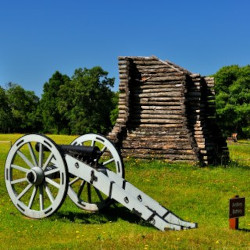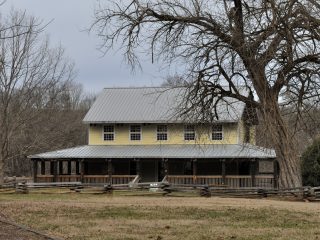Historic Camden Revolutionary War Site

Camden and The Southern Campaign
The Spring and Summer of 1780 were a dark time for Continentals seeking independence from the British Crown. In the North, the British had fought to a standstill. Unable to gain victory and fearing intervention from their Old World adversaries, the British turned their attention to the Southern Colonies.

In what has become known as the Southern Campaign, the British hoped to quickly establish total control of the Southern Colonies, providing them with a safe base of operations to attack the middle colonies, and depriving the rebellion of much needed supplies originating from the then safe Southern Colonies.
Major General Henry Clinton set sail from New York the day after Christmas 1779 with 8,500 troops and a fleet of warships intent on pacifying the southern colonies. By 1 February 1780, he had landed his army 30 miles south of Charleston SC. He slowly consolidated his position and when he was ready on March 29, he lay siege to Charleston. By May 12, the city had fallen and the British had a foothold in the south.
From that beachhead, troops were sent out to capture strategically important towns. Ninety-Six and Augusta quickly fell to the British onslaught. Lord Charles Cornwallis was dispatched to Camden along with his lieutenant Francis Rawdon. They faced little resistance as they quickly pacified the town by June 1. Afterwards Cornwallis returned to Charleston to take up command of His Majesty’s southern army. Rawdon was left to fortify and command Camden.
British Occupied Camden South Carolina
From the comfort of the large home built by Joseph Kershaw the founder of Camden, Lord Rawdon administered the town and oversaw the construction of fortifications. Camden at the time was roughly two blocks of houses. Rowden ordered a palisade or log wall fortification built around the town. The town was also defended by five earthen fortifications called redoubts. Other structures like the jail and powder magazine were located just outside of the town.

Because of its location along the Wateree River, Camden became the principle British supply post and storage facility for the next year. Equipment was quickly and easily transported from Charleston by river boats. From Camden, supplies could be sent further north by river or distributed by land to outposts on the interior of the colony.

The location along the river also made Camden an important outpost as far as British Communications were concerned. If, Cornwallis was going to invade North Carolina, he would need to defend Camden at all costs.
Prelude to The Battle of Camden- General Horatio Gates Takes Charge

After the surrender of Charleston, the capture of strategically important towns like Camden, and the obliteration of Colonel Abraham Buford’s troops at the Battle of Waxaws on May 29th the Continental Congress appointed General Horatio Gates commander of the The Southern Army and sent him save the day.
Born in Britain, Gates had severed in the British army and when the American Revolution broke out, he was appointed Adjutant General of the Continental Army. In that post, he proved himself a skilled administrator helping to establish and fledgling army. Although his talents was more suited to overseeing the formation, supply, and record keeping of the army, he longed to prove himself in the field and felt that he should be commanding the Centennial Army instead of Washington.

On August 4, 1777 he was given his chance when he was appointed commander of the Northern Department. Shortly after taking command, he got his first taste of victory at the Battles of Saratoga. Although Gates took credit, his field commanders including Daniel Morgan and Benedict Arnold directed the order of battle with Arnold defying Gates orders and taking the field and rallying troops in fierce battle earning himself the title “Hero of Saratoga”
With this victory under his belt, Gates attempted to displace Washington as Commander-in-Chief of the Continental Army. He used all his skills and political connections, but was unable to defeat Washington’s supporters. After his failed attempt, he faded into obscurity until in 1780, his supporters gave him a second chance to be a hero and wrestle power from Washington.
The Road to the Battle of Camden

Gates arrived in Hillsborough, North Carolina on July 19th 1780 and took command of what he would call his “Grand Army”. He announced his intention to march straight to Camden and liberate the town from British control. The officers under his command advised against such a reckless move. His plan had the army marching through thinly populated lands with few resources deep into enemy territory far away from supply lines. Gates refused to listen, and the army set out on July 27th.
The march was hard on his men and many were starving by August 7th when things started to look up. General Richard Caswell with his contingent of 2,100 North Carolina Militiamen joined the army. A few days later at Rugeley’s Mill just 15 miles north of Camden, General Edward Stevens and his 700 Virginia Militiamen joined the army.
This brought Gates’ total troop count to well over 4000 men, unfortunately the vast majority of his troops were ill equipped and untested militiamen who had never seen battle much less a British bayonet charge. Many of the remaining men were suffering from dysentery and not truly fit to fight. But the Camden garrison under Lord Rawdon only numbered 1,000 men. Gates was confident that he could lead his men to victory.
In the meantime, Lord Cornwallis had been alerted to Gates’ troop movements. Camden was too important to the British war effort to lose. It not only held vast storehouses of powder and other supplies essential to the war effort, but several hundred sick and injured soldiers were recuperating within the safety of the towns walls. Lord Charles Cornwallis personalty marched reinforcements from Charleston and by August 13 he had arrived in Camden and taken command.
The Battle of Camden
August 15, 1780 and First Shots Fired
During the night of August 15, 1780 both armies were traveling under cover of darkness about 8 miles north of Camden. The night march was especially hard on the Americans. The large army made up of mostly fresh recruits had had little time to maneuvered together. Cornwallis army was in much better shape. Although his troop number was only 2200 men compared to Gates 4000, 1400 of Cornwallis’ troops were battle hardened regulars.
When the two armies crossed paths in the night there was a brief moment of confusion as shots were exchanged. But neither side wanted to fight in darkness, so they separated and waited for first light.
August 16, 1780 – The Battle of Camden
Gates remained supremely confident in the morning as he formed his army for a fight. Assessing his opponents troop strength, he clearly had the advantage and was already looking forward to reporting his victory to his superiors.
Falling back on his training in the British Army, he set up his formations in the traditional way. His most experienced troops, the veterans from Maryland and Delaware, were placed on his right flank and his least experienced, the North Carolina and Virginia militias that had never seen battle, formed up along the left. Cornwallis did the same with his veteran 23rd and 33rd Regiments facing off against the North Carolina and Virginia militias. Gates positioned himself well behind the lines.
When the battle commenced, the 800 men of the British 33rd Regiment affixed bayonets and advanced on the 2500 men of the Virginia and North Carolina Militias. At the first sight of the British bayonet charge, the Virginia Militia doped their guns and ran. Their retreat carried over to the North Carolina Militia and with that the majority of Gates’ army was in retreat within minutes of the start of battle. Gates too chose to run. He turned his horse and galloped away, not stopping until he was in Charlotte.

While gates was running for his life, Maj. Gen. Johann de Kalb, the German born soldier who joined the Continental Army along with his friend Lafayette, rallied the Maryland and Delaware regulars along the right flank and made a final heroic stand. As the veteran British 23rd and 33rd Regiments turned from the fleeing militia to engage the only Continentals still on the field de Kalb found himself surrounded by foes. In a final attempt to rally his men, he was shot from his horse and with that,his men finally gave up the hopeless fight.

Aftermath of The Battle of Camden
The Battle of Camden was the worst Patriot defeat of the war. Over 2000 American troops were either killed or taken prisoner, including Maj. Gen. Johann de Kalb who died of his wounds two days later as a prisoner in Camden. Gates survived and after arriving in Charlotte, he continued back to Hillsborough in hopes that his army would have returned. He arrived on the 19th and then made his report to Congress the following day.
All organized resistance to the British in South Carolina was cleared away in just over an hour on that August morning. Cornwallis was free to invade North Carolina and then Virginia unopposed. The only hope of stooping him would be if someone could quickly raise an army and bring them to field. The chances of that were long, so Cornwallis marched on.
Visiting Historic Camden Revolutionary War Site
For details on our visit check out our Historic Camden Revolutionary War Site Field Report

Although the original colonial town of Camden has been lost to war and fire over the more than 240 years since the Battle and occupation, archaeologists have determined where the town once stood and what it may have looked like. The Historic Camden Revolutionary War Restoration site is a 107 acre open aired museum that contains representative buildings of the era and rebuilt fortifications. Even though none of the buildings on the site today are original, most are historical dating to just after the American Revolution to the mid 1800’s.
Kershaw-Cornwallis House at the Historic Camden Revolutionary War Site

What stands on the site today is a reproduction of the original two story Georgian house built by Camden’s founder Joseph Kershaw. During British occupation, it was used as the headquarters of Francis Rawdon and Charles Cornwallis when he was in Camden.
The house survived the Revolution, but was burned during the Civil War. In the 1970’s archaeologists uncovered the original foundations of the Kershaw-Cornwallis House and with the help of photographs and historical descriptions, the house was rebuilt in the late 70’s. Today it still keeps watch over the grassy field that British Soldiers once used as a parade ground. Inside is a museum with lots of period artifacts, most discovered at the Camden site itself.
Other Historic Structures at Historic Camden Revolutionary War Site

While none of the original houses remain, a number of historical homes from the Camden area have been moved to the Revolutionary War Site.

The site office and gift shop are located in the Cunningham House originally built in 1830. Nearby, they have the oldest house on the site. John Craven House house was built in 1785 and today houses a rotating exhibit detailing life in the colony. Across the road, the McCaa House built around 1800 is restored and furnished like a period tavern.
On the backside of the site, there are two additional log homes built around 1800.

Rebuilt Defenses and Displays
Earthen fortifications were rebuilt near the Kershaw-Cornwallis House. Redoubts were earthen fortification s designed to protect troops and assets outside the main town walls. A rebuilt blacksmith’s shed is near the office. It’s fully functional and hosts demonstrations from time to time. Under the shed there are also a pair of cannons used by the British at Camden. They were abandoned when the British finally evacuated the town in 1781 a later discovered by archaeologists.

Events at the Historic Camden Revolutionary War Site
Revolutionary War Field Days
An annual event when red coats take over the Camden common once again. Reenactments and demonstrations are held throughout the weekend led by reenactors from over 20 states. Visitors can walk among them and ask questions.
Second Saturday Rev War Days
A smaller event that takes place every month. Each month has a different theme, but you can expect living history demonstrations and lots of people who can answer any question you have about the US Revolution.
Admission to the Historic Camden Revolutionary War Site

General admission is $5.00 for adults and gives access to the grounds and a self guided tour to the outside of houses.
Guided Tours of the Historic Camden Revolutionary War Site
For $10, you can get a guided tour of the site that includes the inside of the houses and the displays within. Tours take place at 10:30am and 2:30pm Tuesday-Saturday and last about an hour. On the tour you’ll be able to walk inside the Kershaw Mansion, McCaa’s Tavern, and the 18th C. Craven House.
Camden South Carolina Battlefield

The site of the Battle of Camden is about 8 miles north of the Historic Camden Campus on Flat Rock Road. The 476 acre site has a total of 5 short trails, three of them having interpretive signage. The best way to experience the Camden Battlefield is to start on the “Great Road Trail”, the signage gives an introduction and sets the stage for the battle. It ends at the “Eastern Battlefield Trail” that loops back and tells the story of the first shots of the battle and Gate’s retreat. Back at the starting point, the “Western Battlefield Loop” tells the rest of the story.
The battlefield is mostly shaded with young pine trees with some open areas. Parts of the area are owned by a private company and used as a timber farm, so additional roads have been built through the site. This can make following the trails difficult, and the trail signage isn’t the best. Keep an eye out for spray paint trail blazes on trees. The trails stay close to the highway, so as long as you can still hear cars passing by, you won’t get lost even if you loose the trail.
Fast Facts about Historic Camden Revolutionary War Site
| Type: | Revolutionary War Historic Site and Battleground |
| Admission: | $5.00 adult, $4.00 Seniors, Military, or Students. 5 years or younger Free |
| Location: | 222 Broad St, Camden, SC 29020 |
| Website: | http://www.historiccamden.org/ |
| Phone | (803)432 – 9841 |
Things to do: Hiking, walking, events, historical reenactments, picnicking, historical displays








